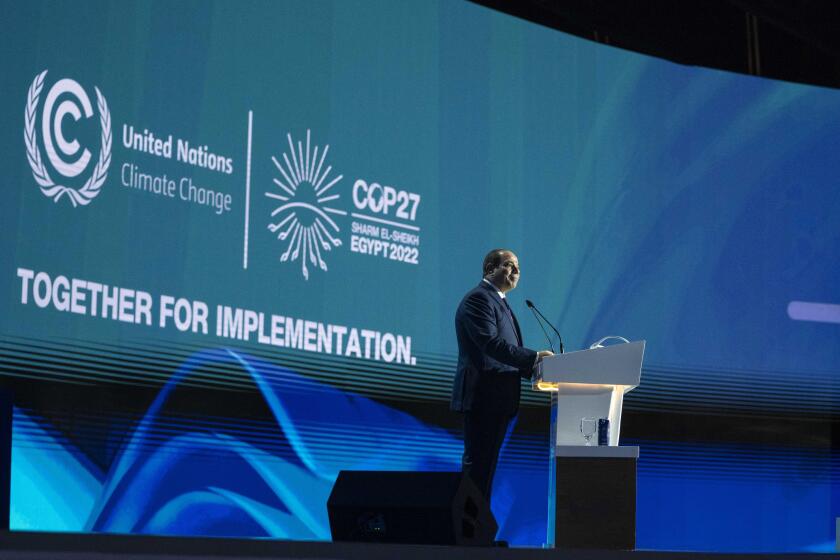Where can California squeeze in more solar panels and wind turbines?

- Share via
Federal officials on Tuesday held their first-ever wind energy lease auction off the West Coast, with dozens of companies competing to build floating wind farms off the California coast that could one day power more than 1.5 million homes.
Though it will be years before any wind turbines are under construction off the coast of Morro Bay and Eureka, it’s the type of project California will increasingly have to pursue to generate enough carbon-free electricity to meet its climate and energy targets.
California’s goal is to cut greenhouse gas emissions 40% below 1990s levels by 2030, reach 90% renewable electricity sales by 2035 and achieve carbon neutrality by 2045.
A new agreement to compensate poor nations for the effects of global warming is an important step for climate justice. But it will be hollow victory until world leaders take decisive action to end fossil fuels.
Transforming an economy that is largely powered by oil, gas and other fossil fuels will mean a lot of new renewable energy construction to meet electricity demand that’s expected to increase by 76% by 2045 as people switch to zero-emission vehicles and appliances.
By 2045, California will have to quadruple its capacity to generate power from the sun and wind. And we’ll need to build many more battery storage systems that will be crucial during hot summer evenings when the sun goes down but demand for air conditioning lingers.
This raises uncomfortable tensions because it will almost certainly mean opening up vast amounts of land to solar and wind farms, including areas with sensitive wildlife habitat (Think of the threatened Joshua trees or Mojave Desert tortoises).
But there are other options worth exploring as well that could ramp up renewable electricity in a thoughtful way, without gobbling up sensitive land and harming the environment in the process.
The Los Angeles Department of Water and Power will no longer shut off water and power for low-income customers who have utility debt. That’s the right decision.
For example, the Los Angeles City Council is looking into installing solar panels over the Los Angeles Aqueduct, which supplies the city with water from the Owens River, to generate electricity while reducing the amount of water lost to evaporation. Some farmers in Colorado and California’s San Joaquin Valley have begun growing shade-loving crops in rows lined with solar panels, in what’s known as agrivoltaics, or converting drought-stricken agricultural fields into solar farms entirely. There are new geothermal power plants in the works that promise to generate clean energy around the clock.
And don’t forget the millions of home and business rooftops, parking lots and other built-out, but underutilized, spaces that can be outfitted with solar panels, or even solar shingles. Even better, they could be paired with batteries that charge during the day and discharge after the sun sets, or with electric cars that feed power back to the grid when demand spikes.
But there are surely many other ideas out there. Where would you like to see more renewable energy built? Are there other creative ways to place wind turbines and solar panels that would use existing structures or limit environmental impacts? Send your suggestions to letters@latimes.com.
More to Read
A cure for the common opinion
Get thought-provoking perspectives with our weekly newsletter.
You may occasionally receive promotional content from the Los Angeles Times.











